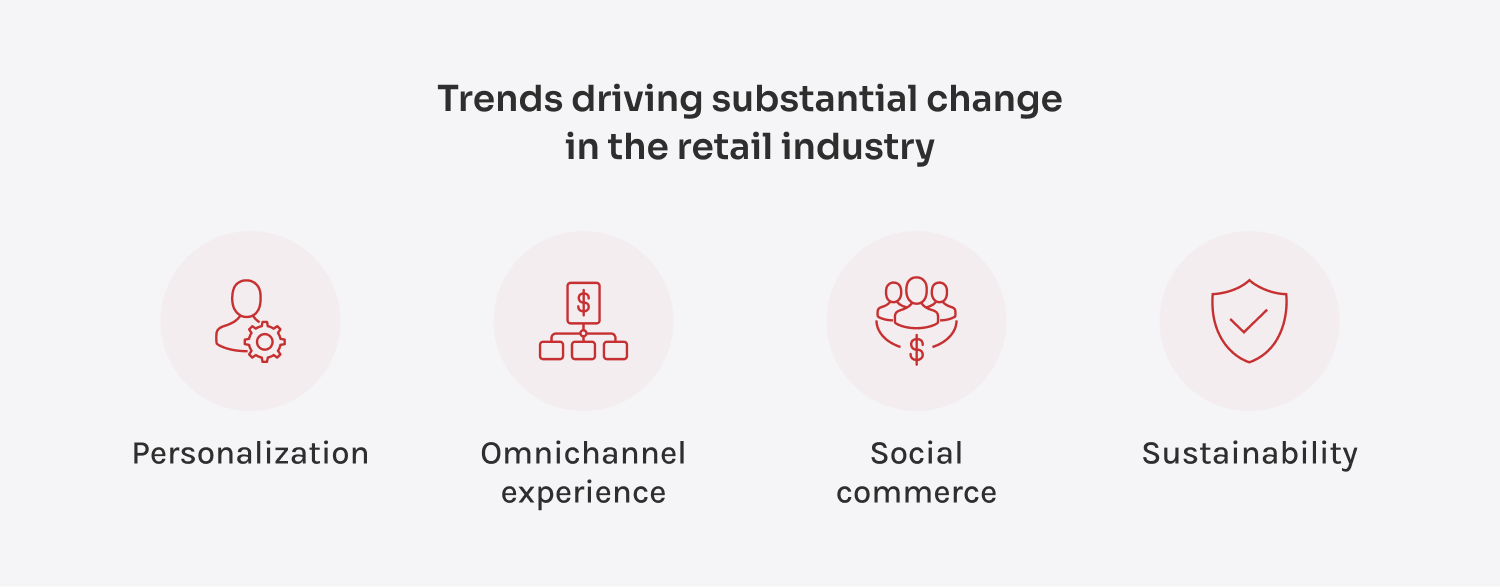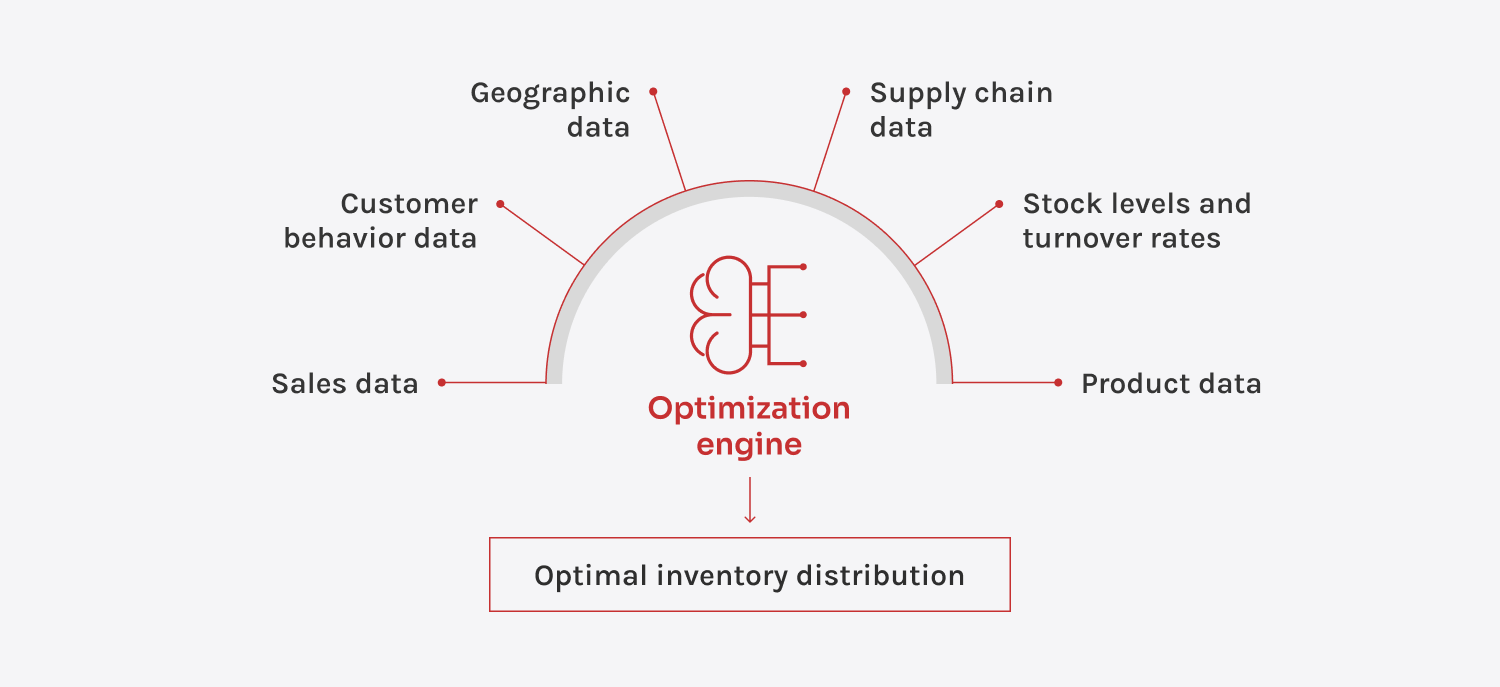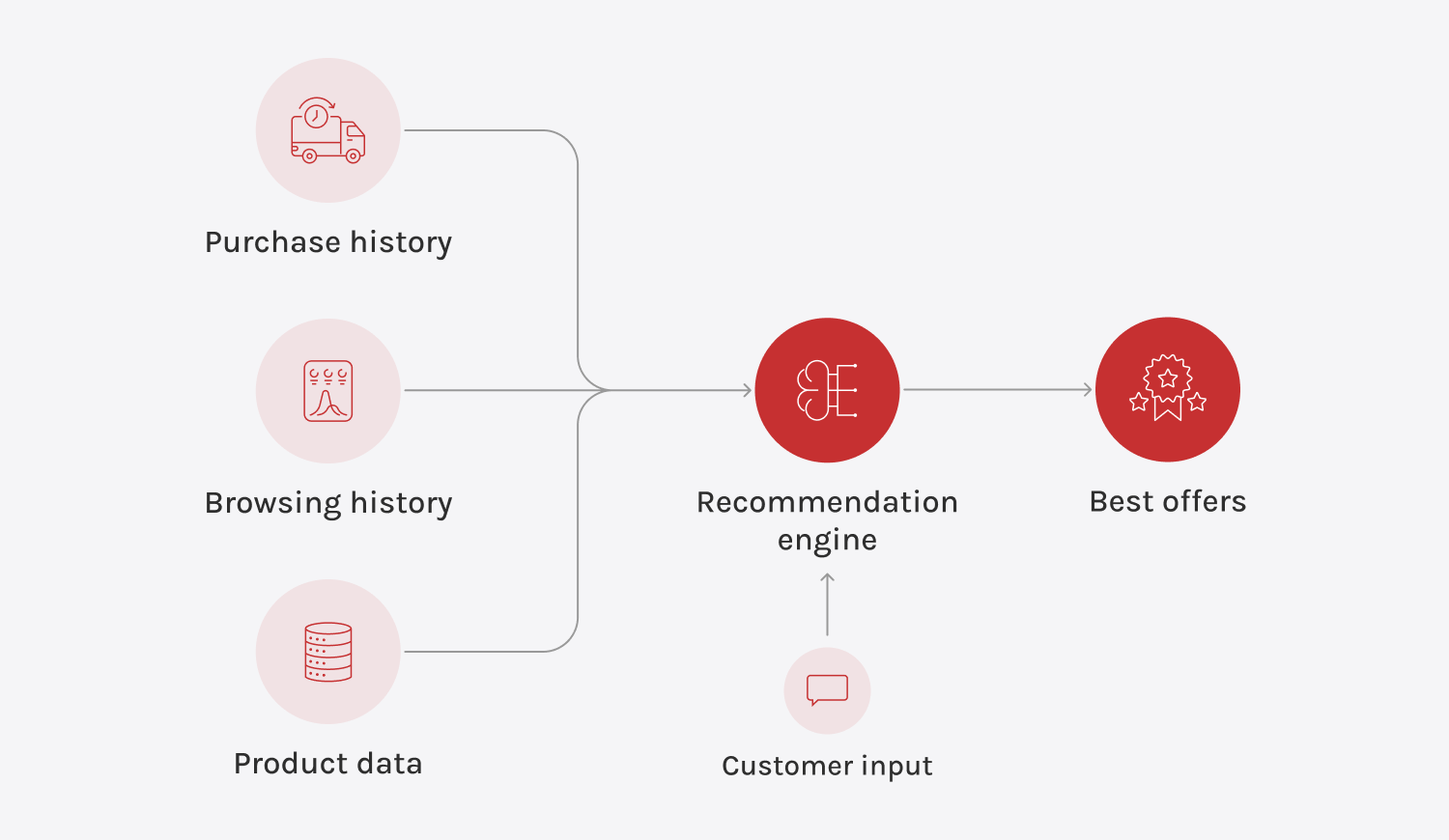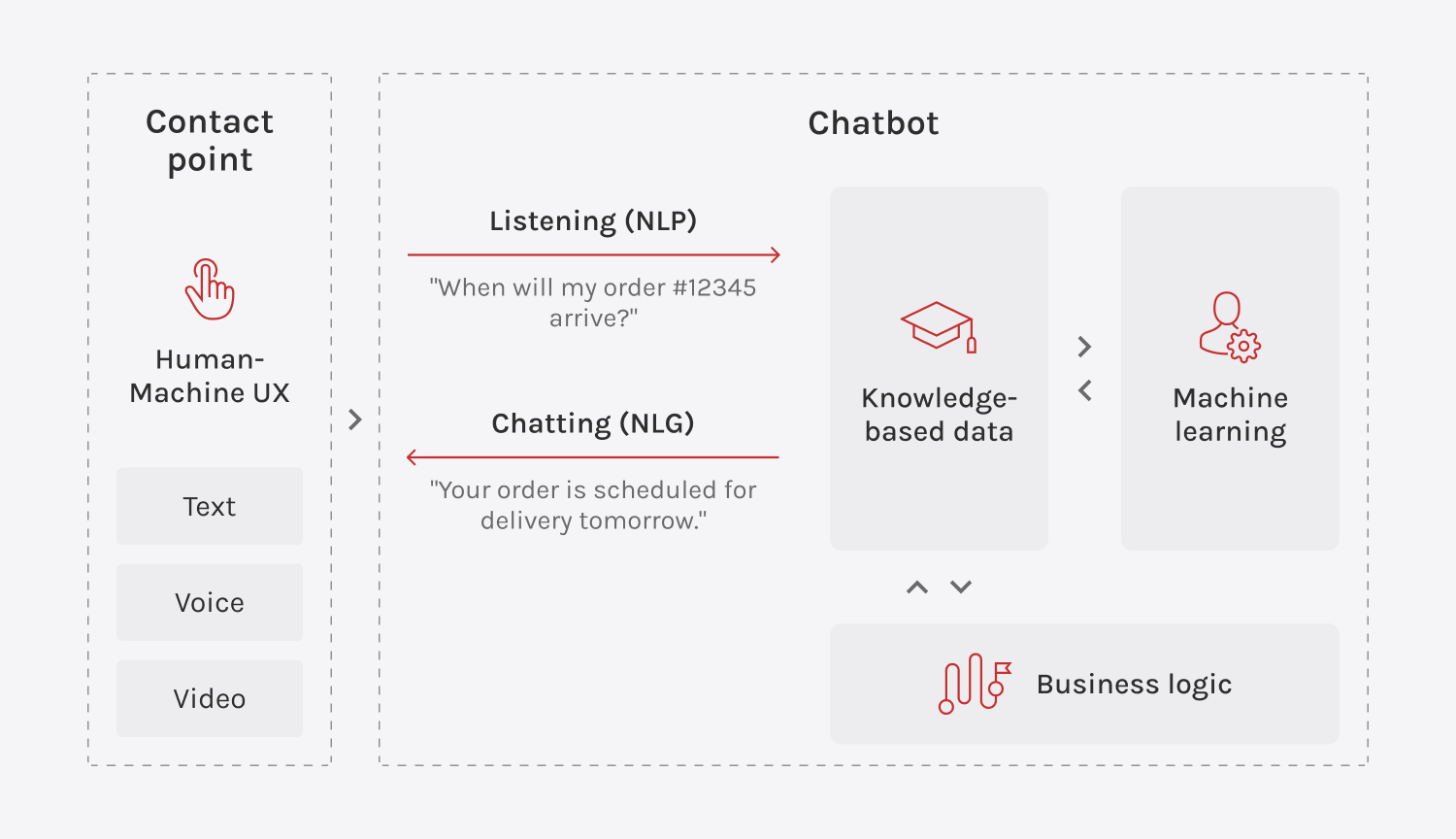Uw bericht is verzonden.
We verwerken je aanvraag en nemen zo snel mogelijk contact met je op.
Het formulier is succesvol verzonden.
Meer informatie vindt u in uw mailbox.


In een wereld waarin het voorspellen van de volgende actie van je klant essentieel is geworden, hoopt machine learning (ML) een magische pil te zijn voor bedrijven. ML kijkt naar enorme hoeveelheden gegevens om klantgedrag te voorspellen en alles te optimaliseren, van personalisatie tot voorraadbeheer.
In dit artikel willen we je laten zien hoe machine learning en eCommerce samenwerken en hoe machine learning kan worden gebruikt in eCommerce om uw omzet te verhogen.
De wereldwijde ML-markt was in 2022 $19,20 miljard waard en zal naar verwachting stijgen naar $225,91 miljard tegen 2030.
Lijkt enorm, toch?
En dat komt allemaal door een paar belangrijke trends die de interactie tussen bedrijven en klanten in de wereld van online winkelen veranderen.
Shoppers verwachten tegenwoordig aanbevelingen op basis van hun gedrag in het verleden en als merken het goed doen, gaan de conversies omhoog. Het gaat erom dat elke winkelervaring voelt alsof die speciaal voor jou op maat is gemaakt.
Omdat kopers steeds vaker verwachten dat ze online kunnen kopen en in de winkel kunnen afhalen, of zelfs in de winkel kunnen rondkijken en online kunnen kopen, vervagen de grenzen tussen digitaal en fysiek winkelen steeds meer.
Platformen zoals Instagram en TikTok veranderen in online marktplaatsen waar je producten kunt kopen. Deze mix van entertainment en e-commerce maakt winkelen gemakkelijker dan ooit.
Steeds meer shoppers geven om de planeet en kiezen merken die hun waarden delen. Van duurzame verpakkingen tot ethisch ingekochte materialen, groen is het nieuwe zwart in de wereld van e-commerce.

Machine learning verandert de manier waarop e-commerce aan de achterkant werkt fundamenteel, waardoor bedrijven gegevens kunnen analyseren en betere beslissingen kunnen nemen in processen die aanzienlijk complexer zijn.
Hierna ontdek je de belangrijkste soorten technologie voor machinaal leren in e-commerce.
Dit soort leren gebruikt gegevens die zowel input als output bevatten. Als je bijvoorbeeld probeert te voorspellen of een klant weggaat of blijft, kan de input dingen zijn zoals hun aankoopgedrag en de output is of ze zijn gebleven of weggegaan.
Om voorspellingen te doen, kijkt een model naar patronen in gegevens uit het verleden, zoals hoe klanten zich gedroegen voordat ze afhaakten, en gebruikt die patronen om toekomstig gedrag te voorspellen. Typische algoritmen voor dit doel zijn neurale netwerken, logistieke regressie, beslisbomen en ondersteunende vectormachines.
In plaats van gelabelde gegevens (waarvan we de uitkomst kennen), krijgt de machine ruwe, ongelabelde gegevens en moet hij zelf patronen of structuren vinden. Zo werkt unsupervised learning.
Veelgebruikte algoritmen bij leren zonder toezicht zijn K-means clustering, dat gelijksoortige items groepeert, en Principal Component Analysis (PCA), dat complexe gegevens vereenvoudigt door zich te richten op de belangrijkste kenmerken. Deze hulpmiddelen helpen de machine verborgen patronen te vinden zonder dat er vooraf gedefinieerde labels nodig zijn.
Dit soort leren is alsof je de machine leert door vallen en opstaan, net zoals mensen leren van hun fouten. De machine interageert met zijn omgeving, onderneemt acties en krijgt feedback in de vorm van beloningen of straffen. Na verloop van tijd leert de machine welke acties tot de beste resultaten leiden.
Een algoritme dat vaak wordt gebruikt in versterkingsleren is Q-leren, dat de machine helpt om de beste actie te bepalen in elke situatie op basis van ervaringen uit het verleden.
Dit type machinaal leren houdt in dat het systeem wordt getraind om nieuwe gegevens te creëren die sterk lijken op de gegevens waarop het is getraind. In tegenstelling tot andere vormen van leren die zich richten op classificeren of voorspellen, richt generatieve AI zich op het creëren van iets nieuws.
Een populair model dat hiervoor wordt gebruikt is GAN (generative adversarial networks), dat uit twee delen bestaat: het ene genereert nieuwe gegevens en het andere evalueert deze om te bepalen of ze realistisch genoeg zijn. De twee delen concurreren met elkaar, waardoor het model na verloop van tijd beter en overtuigender wordt. Deze benadering wordt vaak gebruikt bij het maken van afbeeldingen.
Het maakt niet uit welk ML-type, wij kunnen u helpen om het te laten werken voor uw e-commercebedrijf
Machine learning in eCommerce richt zich voornamelijk op twee belangrijke gebieden: het verbeteren van de interne bedrijfsvoering en het verbeteren van de klantervaring. Maar als we wat dieper graven, zien we dat het aantal oplossingen voor machinaal leren in e-commerce veel verder reikt.
Bekijk hieronder enkele voorbeelden van machine learning in eCommerce die innovatie en efficiëntie stimuleren.
Het aanpassen van verouderde marketingstrategieën zou inhouden dat je bulk e-mails stuurt naar een klantenbestand met vooraf gedefinieerde kortingen. Met behulp van ML kunnen kortingsstrategieën echter verschillen tussen individuen, afhankelijk van hun aankoopgedrag in het verleden.
Door mensen relevante aanbiedingen te sturen kun je de klantloyaliteit verhogen, dankzij de hoge kans op een daadwerkelijke conversie. Klanten houden ervan als ze aanbiedingen krijgen die zijn afgestemd op hun interesses, waardoor ze zich tevreden voelen en terugkerende klanten worden.
Op platforms zoals H&M vertrouwen functies zoals de gepersonaliseerde startpagina, Styleboard en Visual Search op ML om stijlen en bijpassende artikelen aan te bevelen op basis van gebruikersgegevens, waaronder browsegeschiedenis, trends en afbeeldingen die door andere klanten zijn gedeeld. ML-algoritmes optimaliseren ook de kassa-ervaring door betaal- en promotieopties op maat aan te bieden op basis van regionale voorkeuren en eerder klantgedrag.
Stel dat je een reeks producten verkoopt, van elektronica tot kleding. Na verloop van tijd zie je dat draagbare luidsprekers een verkoophit worden. In plaats van te wachten op menselijke tussenkomst, komen ML-algoritmes tevoorschijn. Ze monitoren de vraag in microseconden om het aantal aanvragen voor het product in kwestie te bepalen en doen een suggestie om de prijs te verhogen als er een piek is. Tegelijkertijd volgt ML de prijzen van je concurrenten en past jouw prijzen daarop aan.
Om je niet te overstelpen met feiten zonder het juiste bewijs, kun je een voorbeeld uit de echte wereld nemen. De prijstool van Adspert gemaakt met AWS-diensten zoals Amazon SageMaker, maakt gebruik van een machine learning-model om producten dynamisch te herprijzen op basis van factoren zoals zichtbaarheid, winstmarges en concurrentie. Deze tool helpt verkopers om hun producten zichtbaar te houden, wat uiteindelijk de verkoop stimuleert.
In een ander scenario, stel je voor dat je een loyaal klantenbestand hebt. ML beloont die loyaliteit door je klanten extra waarde te bieden. Het analyseert wanneer shoppers in een bepaalde periode hetzelfde product kopen en geeft er een persoonlijk prijskaartje aan voor dat tijdsbestek of biedt verleidelijke kortingen.
Verkopers gebruiken machine-learningmodellen voor eCommerce om een beter inzicht te krijgen in verkoop- en seizoentrends. Met het model kunnen ze de vraag nauwkeurig voorspellen, waardoor ze kunnen voorkomen dat ze uitverkocht raken van best verkopende producten (en klanten ongerust maken) of dat ze te veel voorraad aanleggen van slecht verkopende artikelen, wat leidt tot te grote voorraden en hogere opslagkosten.
Door de handmatige inventarisatie bij te houden, kan ML geautomatiseerd beleid voeren voor nabestellingen of herverdeling van voorraden.
Stel dat een product dat op een bepaalde locatie wordt aangeboden snel verkoopt, dan kan het systeem het product automatisch bijbestellen bij leveranciers of voorraad overhevelen van een andere locatie. Daarnaast kan ML anticiperen op verstoringen in de toeleveringsketen en zelfs alternatieven zoeken, zoals het wisselen van leverancier of het wijzigen van de verzendroute.

Hier is nog een voorbeeld dat kan helpen om je perspectief te bepalen. Walmart maakt gebruik van AI en machine learning om voorraadbeheer te optimaliseren en een uitzonderlijk winkelseizoen voor de feestdagen te realiseren. Met historische gegevens, voorspellende analyses en geavanceerde supply chain-systemen laat Walmart klanten de producten vinden die ze nodig hebben op het juiste moment en op de juiste plaats, terwijl de kosten laag blijven.
Wanneer klanten naar producten zoeken op uw e-commerceplatform, treedt machine learning op als een slimme personal shopper. Het houdt bij waar ze eerder op hebben geklikt, wat ze hebben gekocht en waar ze hebben gezocht en gebruikt die gegevens om de zoekresultaten aan te passen.
Dus als een klant een zwak heeft voor een bepaald merk sneakers, zal een ML-powered site die schoenen als eerste tonen, zelfs als de zoekopdracht niet helemaal juist is of een typefout bevat. Geen "Bedoelde u...?" pop-ups meer, maar resultaten die direct duidelijk zijn. Als ze ineens op zoek zijn naar wandelschoenen of een nieuwe kleur, schakelt machine learning over en krijgen die items voorrang in de zoekresultaten. Na verloop van tijd begint de zoekfunctie van een site te voorspellen wat klanten willen en helpt het hen sneller te vinden.
Nog een voorbeeld uit de echte wereld om te inspireren en het punt te illustreren. Alibaba's AI-innovaties, zoals Taobao Wenwen, verbeteren de zoekresultaten door gepersonaliseerde productaanbevelingen te doen, voor- en nadelen samen te vatten en multimedia-inhoud te bieden zoals video's en livestreams die direct gekoppeld zijn aan zoekopdrachten.
Machine learning in eCommerce analyseert het gedrag van klanten om normale patronen vast te stellen en afwijkingen of anomalieën snel te detecteren. Het kan bijvoorbeeld transacties signaleren die afkomstig zijn van een onverwachte locatie of een plotselinge piek in aankopen met een hoge waarde.
Wanneer ML iets verdachts ziet, kan het systeem onmiddellijk actie ondernemen, zoals de transactie blokkeren of om extra verificatie vragen, terwijl legitieme klanten vrij kunnen winkelen. Naarmate fraudeurs met nieuwe tactieken komen, wordt het systeem slimmer door zichzelf te updaten met nieuwe gegevens.
Dit betekent dat eCommerce machine learning fraude kan terugdringen, het vertrouwen van klanten kan behouden en zich kan richten op groei zonder constant te controleren op bedreigingen. Het perfecte voorbeeld hiervan is Amazon's ML-oplossingen voor fraudedetectie die risico's onmiddellijk evalueren, zodat bedrijven onmiddellijk kunnen handelen. Verdachte activiteiten kunnen ter plekke worden geblokkeerd of geweigerd, terwijl vertrouwde transacties probleemloos doorgaan.
Laten we eens wat dieper kijken naar eBay. Ze investeren jaarlijks miljoenen in technologieën, partnerschappen en personeel om onwettige aanbiedingen te bestrijden. Het platform gebruikt een combinatie van geautomatiseerde filters, beeldherkenning, tools voor machinaal leren en handmatige beoordeling door agenten om proactief problematische aanbiedingen op te sporen en te verwijderen voordat ze op de site verschijnen.
Een online winkelmarketingstrategie die goed presteert, kan nog effectiever zijn als er machine learning e-commerce marketing bij betrokken is. ML-algoritmen kunnen bijvoorbeeld klanten segmenteren op basis van hun koopgedrag, browsegeschiedenis en voorkeuren, waardoor bedrijven gepersonaliseerde aanbiedingen of aanbevelingen kunnen sturen. Het kan ook klanten identificeren die waarschijnlijk zullen afhaken door hun activiteiten te analyseren, zodat bedrijven proactief stappen kunnen ondernemen, zoals het sturen van gerichte retentieaanbiedingen.

Het is opmerkelijk dat bedrijven zoals Starbucks AI gebruiken om klantgedrag te analyseren en gepersonaliseerde promoties of aanbevelingen aan te bieden via hun Deep Brew-programma. AI maakt efficiëntere segmentatie mogelijk om de juiste boodschap op het juiste moment aan het juiste publiek te sturen.
Traditionele A/B-tests bestaan uit het maken van meerdere versies van een webpagina om te bepalen welke beter presteert. Het is langzaam, vervelend en, eerlijk gezegd, een beetje ouderwets. Machine learning daarentegen versnelt het proces. Elk klein element op een pagina - de CTA-knop, het kleurenschema of de lay-out - wordt dynamisch getest en geoptimaliseerd op basis van verschillende meetwaarden zoals conversiepercentages en klikken.
En het beste deel? Het kan continu analyseren en aanpassen, en de beste configuratie sneller identificeren dan een mens zou kunnen. Dus in plaats van dagen- of wekenlang experimenten uit te voeren, kan AI binnen enkele minuten pagina's verfijnen.
Stel je voor dat je een online bestelling plaatst en deze vrijwel direct bij je thuis ontvangt. Dat soort snelheid wordt aangedreven door machine learning dat enorme hoeveelheden gegevens - je winkelgewoonten, voorraadniveaus, zelfs de toestand van de wegen - gebruikt om snelle beslissingen te nemen die levertijden en logistiek optimaliseren.
Neem bijvoorbeeld Walmart. AI wordt gebruikt om productcatalogi samen te stellen, klant- en winkeltrends te analyseren en de logistiek te versnellen voor externe verkopers die Walmart Fulfillment Services gebruiken. Ondertussen gebruikt Amazon generatieve AI om nog een stap verder te gaan. Het optimaliseert bezorgroutes, verbetert magazijnrobotica en voorspelt waar de voorraad moet worden geplaatst om verzending op dezelfde dag werkelijkheid te laten worden.
Wanneer klanten afbeeldingen uploaden of foto's maken, analyseren ML-algoritmes de beelden, matchen ze met productcatalogi en suggereren gelijkaardige items. Visuele aanbevelingen personaliseren ook de winkelervaring op basis van het gedrag van een gebruiker in het verleden. Virtueel uitproberen, ondersteund door augmented reality (AR), kunnen klanten zien hoe producten zoals kleding of accessoires hen zouden staan voordat ze tot aankoop overgaan.
Een goed voorbeeld is het bekende L'Oréal Parijs. Het merk is een samenwerking aangegaan met ModiFace, de leider op het gebied van beautytechnologie, om een meeslepende virtuele make-upsimulator te creëren. De virtuele probeerfunctie wordt gevoed door augmented reality om realistische make-upsimulaties te bieden, waardoor gebruikers hun schoonheidservaring kunnen personaliseren.
Via spraak zoeken kunnen klanten producten vinden met behulp van commando's in natuurlijke taal. ML-gestuurde spraakassistenten bieden ook realtime klantenondersteuning door vragen te beantwoorden of te helpen met het volgen van bestellingen. Met behulp van Azure AI-technologieën, ASOS geïntegreerde taalmodellen en trendgegevens om direct modeselecties samen te stellen, met de nadruk op de voorkeuren van de klant en de laatste modetrends.
ML gaat verder dan eenvoudige trefwoorden; het begrijpt context, sarcasme en emotionele ondertonen en legt sentimenten vast die anders misschien over het hoofd worden gezien. Hierdoor kunnen bedrijven zorgen sneller aanpakken en de vinger aan de pols houden van trends, zodat ze hun strategieën hierop kunnen aanpassen.
Een goed voorbeeld is Amazon dat AI gebruikt om gebruikers te helpen snel door recensies te navigeren en deze te begrijpen, bijvoorbeeld door samenvattingen te genereren die gemeenschappelijke thema's en gevoelens uit recensies weergeven.
Social listening maakt gebruik van geavanceerde tools om sociale media en online platforms te monitoren op relevante vermeldingen, hashtags of trefwoorden. Ze kunnen ook het sentiment analyseren, vergelijkbaar met sentimentanalyse, maar met een bredere focus op conversaties rond een onderwerp in plaats van individuele beoordelingen of feedback.
Zara's aanpak om inzicht te krijgen in de behoeften van de consument en het productaanbod aan te passen, leunt zwaar op realtime feedback van klanten. Het bedrijf gebruikt gegevens van sociale media en e-mailenquêtes om rechtstreeks inzichten te verzamelen van het klantenbestand.
Deze chatbots zijn gebaseerd op natuurlijke taalverwerking (NLP), waardoor ze vragen van gebruikers kunnen begrijpen en er accuraat op kunnen reageren.
Als een klant bijvoorbeeld vraagt: "Wanneer komt mijn bestelling #12345 aan?", identificeert de chatbot de intentie (een vraag over levering) en haalt hij de belangrijkste informatie eruit (het bestelnummer). Vervolgens haalt hij de relevante gegevens op uit de database en geeft hij een duidelijk antwoord, zoals: "Uw bestelling staat gepland voor levering morgen."

Innowise ontwikkelde een AI-gebaseerd analyseplatform dat ML gebruikt om advertentiecampagnes te optimaliseren door zoekopdrachten van gebruikers te matchen met de meest relevante advertenties, waardoor de dekking van zoekwoorden en advertentierelevantie wordt verbeterd. De oplossing verhoogde het aantal advertentieklikken met 53%, verkortte de tijd voor het genereren van advertenties met 25% en bereikte een dekking van 92% van gebruikersverzoeken.
Ons team integreerde OpenAI's GPT-modellen in een no-code websitebouwplatform, waardoor AI-gestuurde codegeneratie en contentcreatie mogelijk werd. Het resultaat was dat de oplossing de tijd die nodig was voor het aanpassen van de website met 60% verkortte, de SEO verbeterde met geoptimaliseerde metabeschrijvingen en de ranking in zoekmachines met 17% verbeterde.
We hebben het ecosysteem voor digitale media van onze klant getransformeerd door geavanceerde AI-oplossingen te integreren om webapps te moderniseren, de gebruikerservaring te verbeteren en de operationele efficiëntie te optimaliseren. Tot de belangrijkste resultaten behoren een toename van het aantal maandelijkse bezoekers met 12% en een verlaging van de kosten voor professionele fotografie met 66% dankzij tekst-naar-beeld generatieve AI.
ML kan uw bedrijf optimaliseren, personaliseren en opschalen - laten we eens kijken wat het beste bij u past!
Natuurlijk, eCommerce ML zorgt voor gepersonaliseerde winkelervaringen, voorspelt de behoeften van klanten en stuurt zakelijke beslissingen met ongelooflijke precisie aan. Maar achter alle opwinding gaat een reeks uitdagingen schuil die vaak onopgemerkt blijven.
Laten we eens wat dieper ingaan op de hindernissen waar e-commerce met machine learning mee te maken kan krijgen en wat er gedaan kan worden om deze hindernissen te nemen.
Uitdaging
Oplossing
ML-modellen zijn sterk afhankelijk van grote hoeveelheden gegevens van hoge kwaliteit, maar e-commercebedrijven worstelen vaak met onvolledige en inconsistente datasets.
De initiële kosten voor het implementeren van machine learning-algoritmen voor e-commerce kunnen hoog zijn, maar de efficiëntie en het rendement op investering zullen het op de lange termijn ongetwijfeld waardevol maken. Bedrijven kunnen een concurrentievoordeel ontwikkelen, tevredenheidspercentages verhogen en meer winst maken door dergelijke tools te integreren. Ons team helpt u graag om machine learning in eCommerce in uw voordeel te gebruiken.













Uw bericht is verzonden.
We verwerken je aanvraag en nemen zo snel mogelijk contact met je op.

Door u aan te melden gaat u akkoord met onze Privacybeleidmet inbegrip van het gebruik van cookies en de overdracht van uw persoonlijke gegevens.